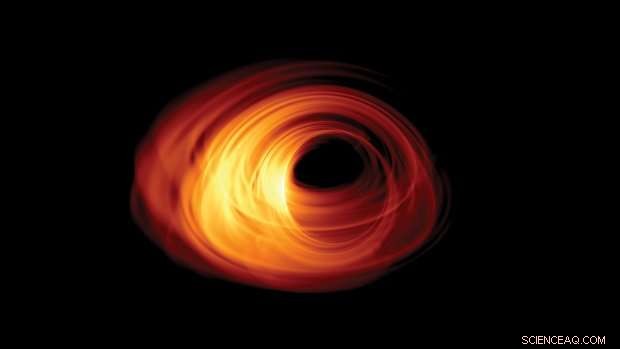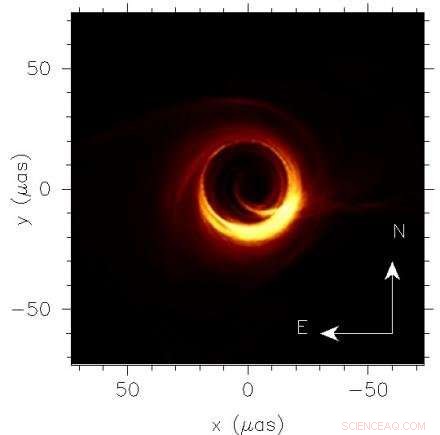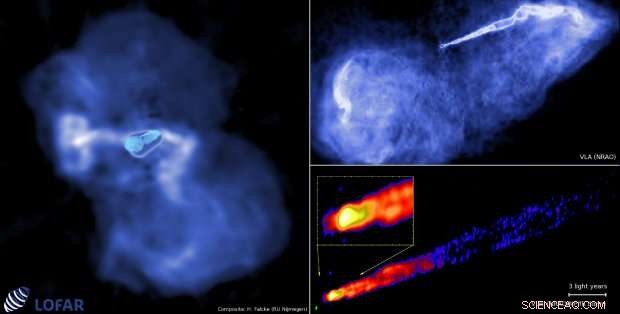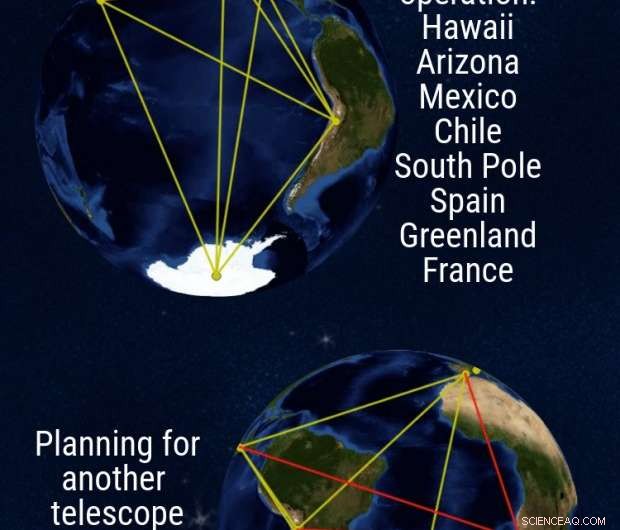
Skuggan av ett svart hål omgivet av en ring av eld i en generisk simulering. Kredit:T. Bronzwaer, M. Moscibrodzka, H. Falcke Radboud högskola
I de svarta hålens skuggiga områden kolliderar två grundläggande teorier som beskriver vår värld. Kan dessa problem lösas och finns det verkligen svarta hål? Först, vi kanske måste se en och forskare försöker göra just detta.
Av fysikens alla krafter finns det en som vi fortfarande inte alls förstår:gravitationen.
Tyngdkraften är där grundläggande fysik och astronomi möts, och där de två mest grundläggande teorierna som beskriver vår värld – kvantteorin och Einsteins teori om rumtid och gravitation (aka. teorin om allmän relativitet) – kolliderar direkt.
De två teorierna är till synes oförenliga. Och för det mesta är detta inga problem. De lever båda i olika världar, där kvantfysiken beskriver de mycket små, och allmän relativitetsteori beskriver de allra största skalorna.
Endast när du kommer till mycket små skalor och extrem gravitation, kolliderar de två teorierna, och på något sätt, en av dem har fel. Åtminstone i teorin.
Men det finns en gång i universum där vi faktiskt kunde se detta problem uppstå i verkligheten och kanske till och med lösa det:kanten på ett svart hål. Här, vi finner den mest extrema gravitationen. Det finns bara ett problem – ingen har någonsin "sett" ett svart hål.
Så, vad är ett svart hål?
Föreställ dig att hela dramat i den fysiska världen utspelar sig i rumtidens teater, men gravitationen är den enda "kraften" som faktiskt modifierar teatern där den spelar.
Tyngdkraften styr universum, men det kanske inte ens är en kraft i traditionell mening. Einstein beskrev det som en konsekvens av rumtidens deformation. Och kanske passar den helt enkelt inte in i standardmodellen för partikelfysik.
När en mycket stor stjärna exploderar i slutet av sin livstid, dess innersta del kommer att kollapsa under sin egen gravitation, eftersom det inte längre finns tillräckligt med bränsle för att upprätthålla trycket som arbetar mot tyngdkraften (ja, gravitationen känns trots allt som en kraft, gör det inte!).
Saken kollapsar och ingen kraft i naturen är känd för att kunna stoppa den kollapsen, någonsin.
På oändlig tid, stjärnan kommer att ha kollapsat till en oändligt liten punkt:en singularitet – eller för att ge den ett annat namn, ett svart hål.
Självklart, om en begränsad tid kommer stjärnkärnan att ha kollapsat till något av en ändlig storlek och detta skulle fortfarande vara en enorm mängd massa i ett vansinnigt litet område och det kallas fortfarande ett svart hål!
Svarta hål suger inte in allt runt omkring dem
Intressant, det är inte sant att ett svart hål oundvikligen kommer att dra in allt.
Faktiskt, oavsett om du kretsar runt en stjärna eller ett svart hål som har bildats av en stjärna, det gör ingen skillnad, så länge massan är densamma. Den gamla goda centrifugalkraften och ditt vinkelmoment kommer att hålla dig säker och hindra dig från att falla in.
Bara när du avfyrar dina gigantiska raketpropeller för att bromsa din rotation, kommer du att börja falla inåt.
Dock, när du väl faller mot ett svart hål kommer du att accelereras till högre och högre hastigheter, tills du så småningom når ljusets hastighet.

Simulerad bild som förutspåtts för det supermassiva svarta i galaxen M87 vid de frekvenser som observerats med Event Horizon Telescope (230 GHz). Kredit:Moscibrodzka, Falcke, Shiokawa, Astronomi och astrofysik, V. 586, sid. 15, 2016, återges med tillstånd © ESO
Varför är kvantteori och allmän relativitet oförenliga?
Vid denna tidpunkt går allt fel som, enligt den allmänna relativitetsteorien, ingenting ska röra sig snabbare än ljusets hastighet.
Ljus är det substrat som används i kvantvärlden för att utbyta krafter och för att transportera information i makrovärlden. Ljus avgör hur snabbt du kan koppla orsak och konsekvenser.
Om du går snabbare än ljuset, du kunde se händelser och ändra saker innan de inträffar. Detta har två konsekvenser:
Huruvida det är sant och om och hur teorin om gravitation (eller kvantfysik) behöver modifieras är en fråga för intensiv debatt bland fysiker, och ingen av oss kan säga åt vilket håll argumentet kommer att leda till slut.
Finns det ens svarta hål?
Självklart, all denna upphetsning skulle bara vara berättigad, om svarta hål verkligen fanns i detta universum. Så, gör de?
Under det senaste århundradet har starka bevis byggts upp för att vissa binära stjärnor med intensiva röntgenstrålning i själva verket är stjärnor som kollapsat till svarta hål.
Dessutom, i galaxernas centrum finner vi ofta bevis för enorma, mörka koncentrationer av massa. Dessa kan vara supermassiva versioner av svarta hål, möjligen bildat genom sammanslagning av många stjärnor och gasmoln som har sjunkit in i mitten av en galax.
Bevisen är övertygande, men omständighet. Åtminstone har gravitationsvågor låtit oss "höra" sammansmältningen av svarta hål, men händelsehorisontens signatur är fortfarande svårfångad och än så länge, vi har faktiskt aldrig "sett" ett svart hål – de tenderar helt enkelt att vara för små och för långt och, i de flesta fallen, ja, svart...
Så, hur skulle ett svart hål se ut egentligen?
Om du kunde titta rakt in i ett svart hål skulle du se det mörkaste mörkret, du kan föreställa dig.
Men, de omedelbara omgivningarna av ett svart hål kan vara ljusa när gaser spiralerar inåt – bromsas ner av draget av magnetfält som de bär med sig.
På grund av den magnetiska friktionen kommer gasen att värmas upp till enorma temperaturer på upp till flera tiotals miljarder grader och börja stråla ut UV-ljus och röntgenstrålar.
Ultraheta elektroner som interagerar med magnetfältet i gasen kommer att börja producera intensiva radioemissioner. Således, svarta hål kan glöda och kan vara omgivna av en ring av eld som strålar ut på många olika våglängder.
En ring av eld med en mörk, mörkt centrum
I deras centrum, dock, händelsehorisonten lurar fortfarande och som en rovfågel fångar den varje foton som kommer för nära.

Radio images of the jet in the radio galaxy M87 – observed at lower resolution. The left frame is roughly 250, 000 light years across. Magnetic fields threading the supermassive black holes lead to the formation of a highly collimated jet that spits out hot plasma with speeds close to the speed of light . Credit:H. Falcke, Radboud university, with images from LOFAR/NRAO/MPIfR Bonn
Since space is bent by the enormous mass of a black hole, light paths will also be bent and even form into almost concentric circles around the black hole, like serpentines around a deep valley. This effect of circling light was calculated already in 1916 by the famous Mathematician David Hilbert only a few months after Albert Einstein finalised his theory of general relativity.
After orbiting the black hole multiple times, some of the light rays might escape while others will end up in the event horizon. Along this complicated light path, you can literally look into the black hole. The nothingness you see is the event horizon.
If you were to take a photo of a black hole, what you would see would be akin to a dark shadow in the middle of a glowing fog of light. Därav, we called this feature the shadow of a black hole .
Intressant, the shadow appears larger than you might expect by simply taking the diameter of the event horizon. The reason is simply, that the black hole acts as a giant lens, amplifying itself.
Surrounding the shadow will be a thin 'photon ring' due to light circling the black hole almost forever. Further out, you would see more rings of light that arise from near the event horizon, but tend to be concentrated around the black hole shadow due to the lensing effect.
Fantasy or reality?
Is this pure fantasy that can only be simulated in a computer? Or can it actually be seen in practice? The answer is that it probably can.
There are two relatively nearby supermassive black holes in the universe which are so large and close, that their shadows could be resolved with modern technology.
These are the black holes in the center of our own Milky Way at a distance of 26, 000 lightyears with a mass of 4 million times the mass of the sun, and the black hole in the giant elliptical galaxy M87 (Messier 87) with a mass of 3 to 6 billion solar masses.
M87 is a thousand times further away, but also a thousand times more massive and a thousand times larger, so that both objects are expected to have roughly the same shadow diameter projected onto the sky.
Like seeing a grain of mustard in New York from Europe
Coincidentally, simple theories of radiation also predict that for both objects the emission generated near the event horizon would be emitted at the same radio frequencies of 230 GHz and above.
Most of us come across these frequencies only when we have to pass through a modern airport scanner but some black holes are continuously bathed in them.
The radiation has a very short wavelength of about one millimetre and is easily absorbed by water. For a telescope to observe cosmic millimetre waves it will therefore have to be placed high up, on a dry mountain, to avoid absorption of the radiation in the Earth's troposphere.
Effectively, you need a millimetre-wave telescope that can see an object the size of a mustard seed in New York from as far away as Nijmegen in the Netherlands. That is a telescope a thousand times sharper than the Hubble Space Telescope and for millimetre-waves this requires a telescope the size of the Atlantic Ocean or larger.
A virtual Earth-sized telescope
Lyckligtvis, we do not need to cover the Earth with a single radio dish, but we can build a virtual telescope with the same resolution by combining data from telescopes on different mountains across the Earth.
The technique is called Earth rotation synthesis and very long baseline interferometry (VLBI). The idea is old and has been tested for decades already, but it is only now possible at high radio frequencies.

Layout of the Event Horizon Telescope connecting radio telescopes around the world (JCMT &SMA in Hawaii, AMTO in Arizona, LMT in Mexico, ALMA &APEX in Chile, SPT on the South Pole, IRAM 30m in Spain). The red lines are to a proposed telescope on the Gamsberg in Namibia that is still being planned. Credit:ScienceNordic / Forskerzonen. Compiled from images provided by the author
The first successful experiments have already shown that event horizon structures can be probed at these frequencies. Now high-bandwidth digital equipment and large telescopes are available to do this experiment on a large scale.
Work is already underway
I am one of the three Principal Investigators of the BlackHoleCam project. BlackHoleCam is an EU-funded project to finally image, measure and understand astrophysical black holes. Our European project is part of a global collaboration known as the Event Horizon Telescope consortium – a collaboration of over 200 scientists from Europe, the Americas, Asien, och Afrika. Together we want to take the first picture of a black hole.
In April 2017 we observed the Galactic Center and M87 with eight telescopes on six different mountains in Spain, Arizona, Hawaii, Mexiko, Chile, and the South Pole.
All telescopes were equipped with precise atomic clocks to accurately synchronise their data. We recorded multiple petabytes of raw data, thanks to surprisingly good weather conditions around the globe at the time.
We are all excited about working with this data. Självklart, even in the best of all cases, the images will never look as pretty as the computer simulations. Men, at least they will be real and whatever we see will be interesting in its own right.
To get even better images telescopes in Greenland and France are being added. Dessutom, we have started raising funds for additional telescopes in Africa and perhaps elsewhere and we are even thinking about telescopes in space.
A 'photo' of a black hole
If we actually succeed in seeing an event horizon, we will know that the problems we have in rhyming quantum theory and general relativity are not abstract problems, but are very real. And we can point to them in the very real shadowy regions of black holes in a clearly marked region of our universe.
This is perhaps also the place where these problems will eventually be solved.
We could do this by obtaining sharper images of the shadow, or maybe by tracing stars and pulsars as they orbit around black holes, through measuring spacetime ripples as black holes merge, or as is most likely, by using all of the techniques that we now have, together, to probe black holes.
A once exotic concept is now a real working laboratory
As a student, I wondered what to study:particle physics or astrophysics? After reading many popular science articles, my impression was that particle physics had already reached its peak. This field had established an impressive standard model and was able to explain most of the forces and the particles governing our world.
Astronomy though, had just started to explore the depths of a fascinating universe. There was still a lot to be discovered. And I wanted to discover something.
I slutet, I chose astrophysics as I wanted to understand gravity. And since you find the most extreme gravity near black holes, I decided to stay as close to them as possible.
I dag, what used to be an exotic concept when I started my studies, promises to become a very real and very much visible physics laboratory in the not too distant future.
Denna berättelse publiceras igen med tillstånd av ScienceNordic, den pålitliga källan till engelskspråkiga vetenskapliga nyheter från de nordiska länderna. Läs den ursprungliga historien här.